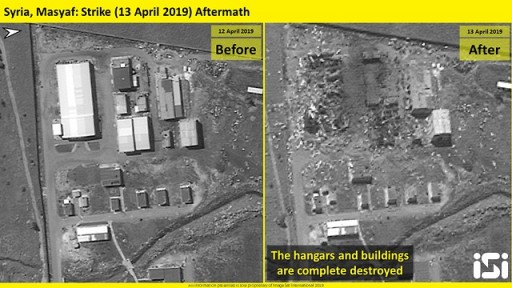 Jerusalem – Satellite images released by the Israeli intelligence firm ImageSat International (ISI) on Sunday showed the complete destruction of a possible Iranian surface-to-surface missile factory in Syria’s Masyaf District, allegedly struck by Israel on Saturday.
Jerusalem – Satellite images released by the Israeli intelligence firm ImageSat International (ISI) on Sunday showed the complete destruction of a possible Iranian surface-to-surface missile factory in Syria’s Masyaf District, allegedly struck by Israel on Saturday.
Subscribe to our Daily Roundup Email
“The main industrial structures were completely destroyed, including the main hangar and the adjacent three production hangers and buildings. The rest of the structures were affected and damaged by the blast,” ISI said, adding they “assess that all the elements and/or equipment which were inside are completely destroyed as well.”
According to ISI, “if the bombed site was indeed a missile factory, it could allow for the production and assembly of different SSM [surface-to-surface missile] elements or for improving the accuracy of missiles.”
The factory was built in the western compound of the base between 2014 and 2016, and was surrounded by a wall to separate it from the rest of the military base. The entrance to the factory passes through the base.
“It is possible that the location of the factory inside what looks like a regular military base was chosen in order to camouflage its real purpose,” ISI said.
While ISI wrote, “It is unclear which entity controls and owns the base” the Syrian army, Iran or militias – if the factory allegedly attacked by Israel was “indeed controlled by Iran, it is probable that the eastern part of the base is controlled by them.”
The possible surface-to-surface missile factory included a main hangar measuring 60 meters by 25 meters, and several big industrial hangars and buildings which probably serve for production and assembly of missiles.
“However, there is probably no manufacture or assembly of missile engines and warheads in this factory, since protected structures weren’t detected. Also no missiles or launchers were identified within the compound,” ISI said.
Israeli officials have repeatedly voiced concerns over Iran’s entrenchment in Syria and the smuggling of sophisticated weaponry to Hezbollah from Tehran to Lebanon via Syria, stressing that both are red lines for the Jewish State.
Israeli Prime Minister Benjamin Netanyahu warned Sunday that anyone who puts Israeli citizens at risk “is in a much greater danger.”
“When Israel’s security is at stake, we are operating at full force, and whoever puts us at risk is in a much greater danger. We will continue to act on all fronts, including on the northern front, because we are not prepared to allow someone to establish power and endanger the State of Israel,” he said.
“Power is the guarantee of our existence, and it is the essential and fundamental condition for achieving peace with our neighbors.”
On Saturday, Syria’s SANA news agency reported that Israel had carried out airstrikes against military positions near the city of Masyaf in Hama Province. SANA quoted a military source as stating that IDF jets carried out the strike from Lebanese airspace around 2:30 a.m. and that Syrian air defenses “immediately intercepted the hostile missiles and downed some of them before reaching their targets.”
While SANA said the interception of the Israeli missiles resulted in the destruction of several buildings and the wounding of three “fighters,” according to a report by the London-based Syrian Observatory for Human Rights (SOHR), Iranian “elements” and pro-Iranian militants were killed and another 17 were injured.
According to SOHR, the strike targeted a Syrian military college in the town and two buildings used by Iranian forces in nearby villages – a development center for medium-range missiles in Zawi and a training camp in Sheikh Ghadban.
In January, Russia deployed its S-300 air defense system to Masyaf. Russia delivered the launcher, radar and command and control vehicle of the advanced air-to-surface missile system to the regime of Syrian President Bashar Assad in early October as a response to the downing of a Russian reconnaissance plane by Syrian air defenses during an Israeli airstrike on Iranian targets the previous month.
The S-300 was not used during the alleged Israeli strike.
